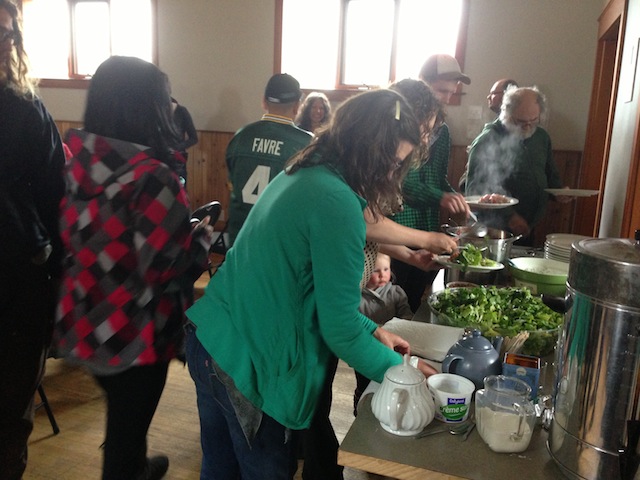Since my last post on Saturday, we have made our way along the route of the Pacific Trails Pipeline, making presentations in both Smithers and Burns Lake. Both of these cities would be impacted by the proposed Pacific Trails gas pipeline and associated infrastructure. In Smithers, we were informed that all hereditary chiefs of the Wet’suwet’en oppose “all pipelines” and the idea of an “energy corridor.” Approving to an “energy corridor” would indicate the approval of not only the Pacific Trails Pipeline, but other energy pipelines as well such as the Enbridge Northern Gateway Pipeline.
We then continued east towards Summit Lake, where the PTP would connect with fracked gas pipelines from northeastern B.C. We decided to drive along Summit Lake Road where we found a natural gas pipeline crossing as well as a gorgeous lake (surprised?) which we were disappointed to see could be threatened by even more pipelines. While I took a photo of the lake, I decided to share this one with you all instead. I may have edited the photo a little.

We drove around Summit Lake, where PTP is proposed to connect with pipelines carrying fracked gas to northeastern B.C. Okay, I may have edited this photo.
After a quick stop at Summit Lake, we continued north through the beautiful northern Rockies and into the Peace Region. We have been here for a number of days where we have been so fortunate to meet with local First Nations, landowners, and environmentalists who are impacted by the rapid industrialization of the north. The proposals for coal mining projects, fracking, pipelines, and mega dams don’t seem to end. The Saulteau First Nations and West Moberly First Nations are handed documents which are so long that they fill up numerous boxes. Some project proposals even fill up entire rooms.
We then visited two families living near fracking wells. They were happy to speak with us, but before sitting down to talk they escorted us into their house and led us to their kitchen sink. They turned on the tap and asked if we wanted to smell their water. We didn’t even have to get too close before we could smell the gas. “It wasn’t always like this. The water changed overnight,” said one of the farmers. “The day after they started fracking is the day I had to stop drinking the water.”
They showed us their toilet water, which had gone black, and continued to tell us how they could not take showers without their eyes stinging and that their children had rashes after showering. Some members of the tour said visiting these residents “was like walking into Gasland.”
The next day, we visited environmentalists and landowners in Fort St. John. The project they were most concerned about is the Site C mega dam proposal. The energy created by this $8-billion dam would be used for Liquified Natural Gas (LNG) plants on the coast — those same plants which would be serviced by the PTP. To understand more about how all of these industrial projects are connected you should read two articles by Damien Gillis: Canada’s Carbon Corridor Part 1 and Part 2.
Community opposition to Site C was very visible. There were billboards in the city and along the highway there were numerous boards saying “Keep the Peace, Stop Site C.” “Keep the Peace” was clearly referring to the Peace River Valley which would be flooded if this dam were to go through. Families would be displaced, farmland would be destroyed, and the climate of the region would be forever changed as was the case with another large dam located only a few hours drive away: the WAC Bennett Dam. After the dam was built, local residents noticed more aggressive winds, as well as massive flooding and land destruction.
To read more about the Site C Dam, visit the Peace Valley Environmental Association website. The PVEA, along with the West Moberly First Nations and Saulteau First Nations will also be taking part in the annual Paddle for the Peace to celebrate the beauty of the Peace River Valley. With the recent Liberal win in the B.C. election, it is more important than ever to keep a close eye on the Peace Region and all of the industrial projects in the North. Christy Clark and industry are adamant in pushing this project through since if the hydro energy from the dam is not used for LNG, the many mines proposed in the region would definitely want it.

In the image you can see “No Dam.”
Ranchers just outside of Fort St. John showed us around their land and how much of it would be destroyed by the proposed Site C dam, the energy from which would go to proposed LNG plants. If the dam went through, they would have to move due to flooding and erosion. On their land they arranged rocks to read “No Dam C.” You can see the lettering from the sky and the river valley below.




